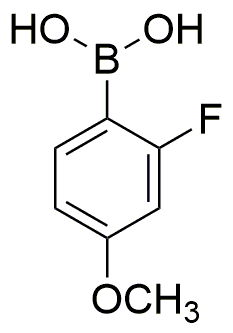2-Fluoro-4-methoxyphenylboronic acid is widely utilized in research focused on:
- Pharmaceutical Development: This compound serves as a crucial building block in the synthesis of various pharmaceuticals, particularly in the development of drugs targeting cancer and other diseases. Its ability to form stable complexes with biomolecules enhances drug efficacy.
- Organic Synthesis: It is commonly used in Suzuki-Miyaura cross-coupling reactions, allowing chemists to create complex organic molecules. This application is vital in the production of agrochemicals and fine chemicals.
- Material Science: The compound is employed in the formulation of advanced materials, such as polymers and coatings, due to its unique properties that improve durability and performance in various applications.
- Bioconjugation: In biochemistry, it is utilized for labeling biomolecules, facilitating the study of protein interactions and cellular processes, which is essential for research in drug discovery and development.
- Analytical Chemistry: This boronic acid derivative is used in sensor technology for detecting sugars and other analytes, providing a sensitive and selective method for monitoring biological and environmental samples.
General Information
Properties
Safety and Regulations
Applications
2-Fluoro-4-methoxyphenylboronic acid is widely utilized in research focused on:
- Pharmaceutical Development: This compound serves as a crucial building block in the synthesis of various pharmaceuticals, particularly in the development of drugs targeting cancer and other diseases. Its ability to form stable complexes with biomolecules enhances drug efficacy.
- Organic Synthesis: It is commonly used in Suzuki-Miyaura cross-coupling reactions, allowing chemists to create complex organic molecules. This application is vital in the production of agrochemicals and fine chemicals.
- Material Science: The compound is employed in the formulation of advanced materials, such as polymers and coatings, due to its unique properties that improve durability and performance in various applications.
- Bioconjugation: In biochemistry, it is utilized for labeling biomolecules, facilitating the study of protein interactions and cellular processes, which is essential for research in drug discovery and development.
- Analytical Chemistry: This boronic acid derivative is used in sensor technology for detecting sugars and other analytes, providing a sensitive and selective method for monitoring biological and environmental samples.
Documents
Safety Data Sheets (SDS)
The SDS provides comprehensive safety information on handling, storage, and disposal of the product.
Product Specification (PS)
The PS provides a comprehensive breakdown of the product’s properties, including chemical composition, physical state, purity, and storage requirements. It also details acceptable quality ranges and the product's intended applications.
Certificates of Analysis (COA)
Search for Certificates of Analysis (COA) by entering the products Lot Number. Lot and Batch Numbers can be found on a product’s label following the words ‘Lot’ or ‘Batch’.
*Catalog Number
*Lot Number
Certificates Of Origin (COO)
This COO confirms the country where the product was manufactured, and also details the materials and components used in it and whether it is derived from natural, synthetic, or other specific sources. This certificate may be required for customs, trade, and regulatory compliance.
*Catalog Number
*Lot Number
Safety Data Sheets (SDS)
The SDS provides comprehensive safety information on handling, storage, and disposal of the product.
DownloadProduct Specification (PS)
The PS provides a comprehensive breakdown of the product’s properties, including chemical composition, physical state, purity, and storage requirements. It also details acceptable quality ranges and the product's intended applications.
DownloadCertificates of Analysis (COA)
Search for Certificates of Analysis (COA) by entering the products Lot Number. Lot and Batch Numbers can be found on a product’s label following the words ‘Lot’ or ‘Batch’.
*Catalog Number
*Lot Number
Certificates Of Origin (COO)
This COO confirms the country where the product was manufactured, and also details the materials and components used in it and whether it is derived from natural, synthetic, or other specific sources. This certificate may be required for customs, trade, and regulatory compliance.


